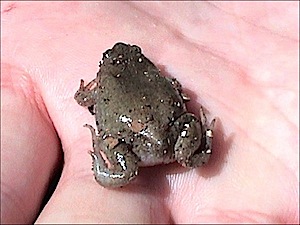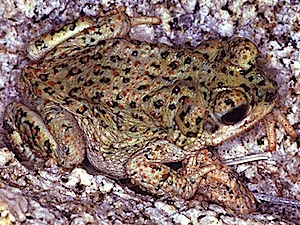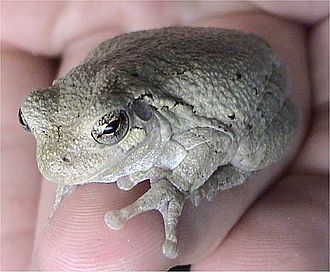|
There are an amazing number of frogs and toads at Berry Springs. This is due to the presence of the many springs as well as Berry Creek. Even during the driest periods there will be some water in the creek and ponds so that they can lay their eggs. Frogs and toads are amphibians and this means that they live both on land and in water. As a result of this amphibians make perfect barometers for the health of the environment and so are often studied as is happening here at Berry Springs.
|
American Bullfrog
(Lithobates catesbeiana)
|
|
The American Bullfrog can be recognized by its large size and green upper lip. It got its name from its bull roar
that can be heard at night. Males may be recognized by their distinctive yellow throats. It lives near the ponds and in swampy areas in the park and it low rumbling call is most often heard near the largest pond. It is prized by many for its tasty and rather large legs! It will protect the area from other frogs where it lives during breeding season. Frog Call |

|
| |
Cope’s Gray Treefrog
(Hyla chrysoscelis)
|

|
This amazing looking frog is colored so that it can disappear while living in its favorite habitat - trees. When it leaps you might be lucky to see the brilliant orange yellow color on the underside of its powerful back legs. It is thought that the flash of color seen while jumping is a mechanism to startle and distract predators. You will only find this frog around ponds during breeding season from May through August. It is extremely rare in the park. Frog Call
|
| |
Green Treefrog
(Hyla cinerea)
|
|
The American Green Tree Frog is nice to have around as it eats flies, mosquitoes and other insects. They are rugged individualists and pair up only during breeding and egg laying periods. They are mostly nocturnal but can be seen on trees and other plants during the day. They are quite common and may even be found in your own back yard. They are popular as pets as they are undemanding and do not need a heated environment. Unfortunately they do not take well to frequent handling so they are best left in the wild. These frogs can be heard in many places around the park. Frog Call
|

|
| |
Great Plains Narrowmouth Toad
(Gastrophryne olivacea) |

|
Have a look in the leaf litter and in moist areas if you wish to find this toad! It is an excellent toad to have around if you wish to get rid of ants as this is its primary diet. It is quite small when compared to most toads growing to only about 1.5 inches in length. The most likely places to see one of these frogs are in the small pools of water below the restrooms. Frog Call
|
| |
Gulf Coast Toad
(Bufo nebulifer)
|
|
This toad is incredibly versatile. It can be found around rivers, streams, marshes, ponds and any area where water is found. It is not unusual to find these toads in back yards. It is best seen at twilight where it comes out to feed on insects attracted by light. Typical sizes range from 2 to 4 inches in length. In the park these are often seen hopping around under lights and on the sidewalks in many different places. It is not unusual to see several of these. At night if you wish to walk along the paths be sure to bring a flashlight to be able to avoid stepping on them. Their calls are quite loud and can drown out many other frog calls. Frog Call
|

|
| |
Blanchard's Cricket Frog
(Acris crepitans blanchardi)
|

|
This small tree frog likes to hang out near stagnant ponds and slow moving waters. It hibernates in the winter and emerges in March. It is an odd looking frog completely covered in warts. (They only resemble "warts".) Their color can vary from bright green to brown and they are often covered with patterns. They love to eat mosquitoes and so are a frog we can really appreciate! They make a tremendous racket that sounds very much like crickets but one can distinguish them by the slowly rising crescendo of sound. It is not unusual to hear several of these frogs at the same time. Listen for them after sunset around just about any body of water in the park. Frog Call
|
| |
Red-spotted Toad
(Bufo punctatus)
|
|
This flat toad can grow up to 3 inches in length. It can live in arid regions and needs only small temporary pools of water to breed. Here it should be found along the creek banks or pond shores under rocks, in burrows or under plant matter when it is dry. It will become quite active during wet, rainy periods. It can be brown as shown here or dark gray. Frog Call
|

|
| |
Rio Grande Leopard Frog
(Rana berlandieri) |
![By Hugo Claessen (http://calphotos.berkeley.edu) [CC BY-SA 2.5 (http://creativecommons.org/licenses/by-sa/2.5) or CC BY-SA 2.5 (http://creativecommons.org/licenses/by-sa/2.5)], via Wikimedia Commons Rio Grande Leopard Frog - Rana berlandieri](Images/Thumbnails/Rana_berlandieri_wiki_TN.jpg)
|
This is a medium sized frog that can grow to more than 4 inches long. It is active at night and lives primarily in the water. During the day you may find them resting at the edges of the ponds and creek. Their calls can be heard nearly a quarter mile away! Although they prefer eating insects they are opportunists and will eat nearly anything they can swallow. This frog is often heard calling from trees that are found around the larger bodies of water in the park. Frog Call
|
| |
Gray Tree Frog
(Hyla versicolor)
|
|
text here: These frogs live in trees and have the ability to slowly change their color to gray to green to camouflage themselves. They can also have black or white mottling. If you hear this frog calling at night then you are hearing the call of the male. They are quite robust and can survive freezing at temperatures down to about 18 degrees Farenheit. As a result this frog can be found in the midwest and eastern half of the US and even up into Canada. Being nocturnal and solitary one can hear single frogs calling from high up in the trees. They usually only descend when they need to mate. Since they depend on insects as their primary food source they can also be seen around lights that attract insects. One possible spot to hear them is high in the trees behind the pond found behind the first camping area and near the bird blind. Frog Call
|

|
| |
More Galleries
|
| Useful (off site) Links
|







![By Hugo Claessen (http://calphotos.berkeley.edu) [CC BY-SA 2.5 (http://creativecommons.org/licenses/by-sa/2.5) or CC BY-SA 2.5 (http://creativecommons.org/licenses/by-sa/2.5)], via Wikimedia Commons Rio Grande Leopard Frog - Rana berlandieri](Images/Thumbnails/Rana_berlandieri_wiki_TN.jpg)
